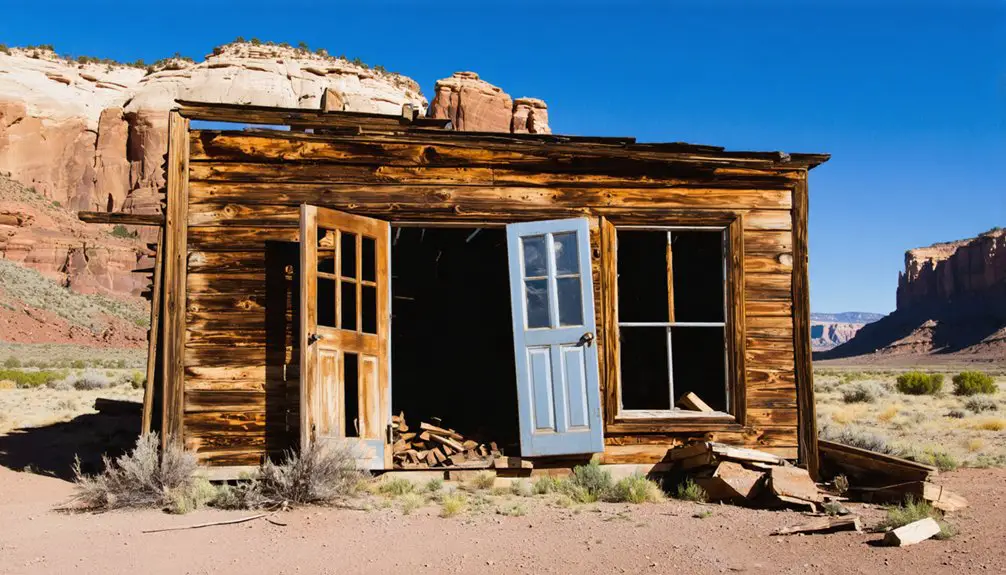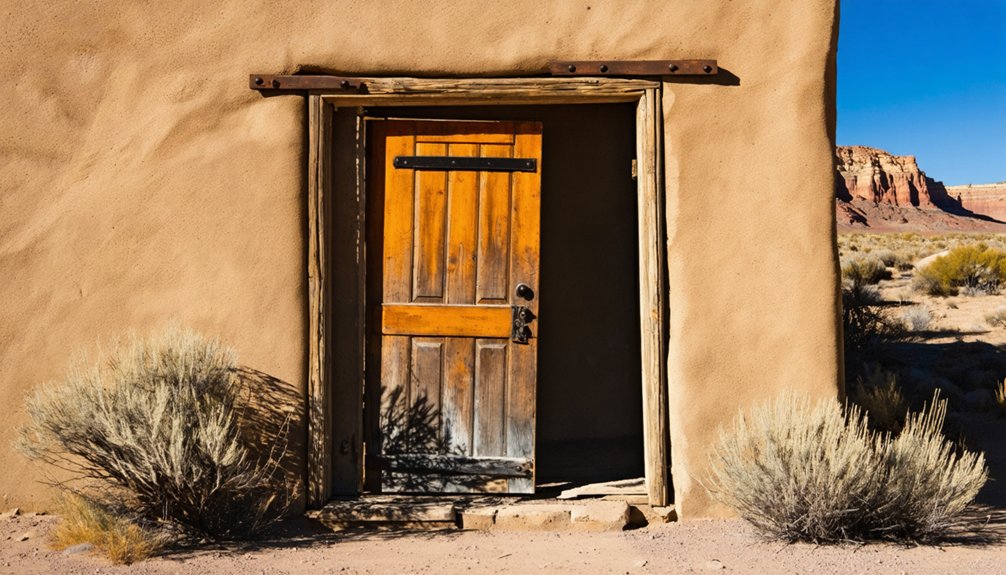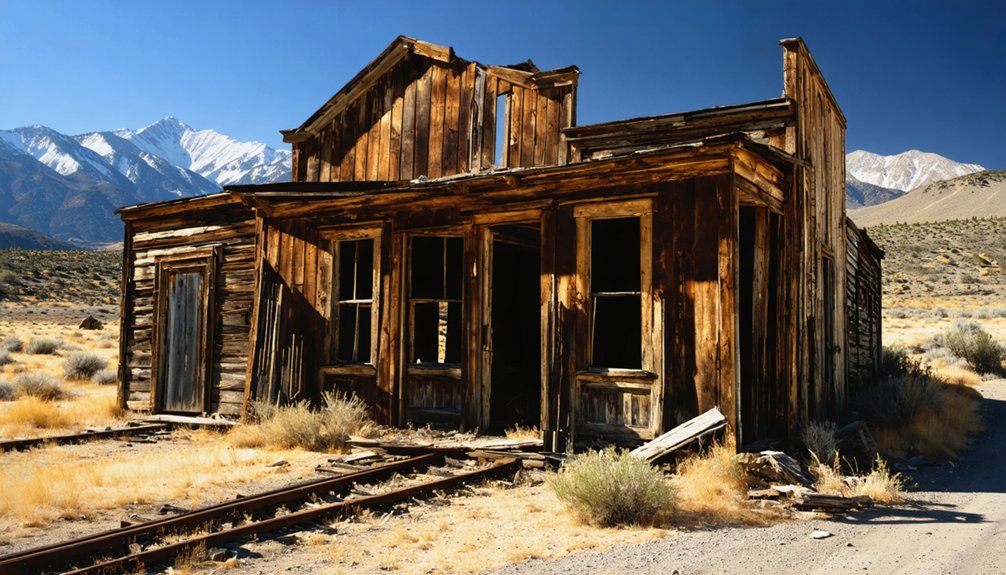You’ll find Elgin’s ghost town ruins along Utah’s Green River, where Thomas Farrer and Matthew Hartman established a settlement in the 1870s. The Denver and Rio Grande Western Railway transformed this former ferry crossing into a bustling agricultural hub, with wheat fields and a mile-long main street. Today, five surviving buildings, including an adobe schoolhouse, and the historic Elgin Cemetery tell stories of railroad workers, farmers, and pioneers who shaped this once-thriving community.
Key Takeaways
- Originally named Blake Station in the 1870s, Elgin emerged as a railroad settlement along the Green River in Utah.
- The Denver and Rio Grande Western Railway transformed Elgin into a thriving agricultural community with efficient crop distribution.
- Agriculture declined due to harsh conditions at 7,500 feet elevation, short growing seasons, and costly irrigation challenges.
- The removal of railroad tracks and declining agricultural shipments led to economic isolation and eventual abandonment.
- Five surviving buildings, including an adobe schoolhouse, remain alongside the historic Elgin Cemetery that dates back to 1865.
The Pioneer Settlement Along Green River
While mail routes between Utah and Colorado were still developing in the late 1870s, a small settlement called Blake Station emerged along the Green River.
You’ll find the roots of this frontier outpost in the determined spirits of the Thomas Farrer and Matthew Hartman families, who braved pioneer hardships to establish the first permanent European presence.
J.P. Blake’s ferry service gave the settlement its initial name, while the Farrers quickly set up a general store and post office to serve travelers along the challenging route.
The historic Spanish Trail crossing was located just three miles upstream, having served as a vital transportation route during the 1830s and 1840s.
Settlement challenges included harsh winters and natural obstacles, yet these founding families persevered. Their tenacity laid the groundwork for what would soon become a bustling railway town, though they couldn’t have imagined the transformative impact the Denver and Rio Grande Western Railway would bring.
The area had long been a crucial trading ground for Indigenous tribes like the Utes and Tumpanawach before European settlement began.
Agricultural Heritage and Railroad Connections
The arrival of the Denver and Rio Grande Western Railway transformed Blake Station into a bustling agricultural hub, soon renamed Elgin.
You’ll find that Elgin’s farmers quickly integrated railroad access into their agricultural operations, hauling crops directly to rail lines for efficient distribution. The town’s strategic location made it a crucial link in Utah’s growing agricultural network.
Like many Utah communities, Elgin’s agriculture centered on dry farming techniques, with winter wheat and grains as primary crops. Farmland increased dramatically between 1890-1900, as Utah’s agricultural development surged across the state.
Local farmers adapted to the arid climate by conserving soil moisture and maximizing limited rainfall. They also cultivated sugar beets, a lucrative cash crop that thrived thanks to rail connections to processing plants. The Reclamation Act of 1902 funded irrigation projects that enhanced crop productivity in the region.
The railroad didn’t just transport crops – it brought in essential farming equipment and supplies, connecting Elgin’s agricultural economy to national markets.
Daily Life in Early Elgin
If you’d lived in early Elgin, you’d have found your daily schedule shaped by the rhythms of railroad shifts and agricultural demands, with railroad workers rising before dawn for track maintenance while farm families tended to livestock and crops.
You would’ve joined your neighbors for community gatherings at the local schoolhouse or around shared meals, where railroad news and farming updates dominated conversations. Much like the residents of Iosepa, the community prided itself on maintaining one of the cleanest towns in the territory. Similar to residents of Silver Reef, locals gathered at the multiple saloons to unwind after long work days.
Your weekends might’ve included social activities like barn raisings, quilting bees, or holiday celebrations that brought together Elgin’s railroad workers and farming families in communal solidarity.
Railroad Workers’ Daily Routines
Railroad workers in early Elgin faced grueling daily routines that started at dawn and continued until dusk.
You’d find specialized crews performing distinct tasks – some laying ties, others positioning rails on rollers, and teams of spikers securing the track.
Mormon laborers, known for their disciplined work routines, focused on the challenging terrain of Echo and Weber canyons.
As crews advanced westward, they’d relocate their camps to stay close to the expanding track.
The labor conditions were intense: grading the land, tamping gravel around ties, and maintaining track stability.
Supply trains had to keep pace, bringing ties and rails to the construction front.
While other railroad camps often descended into chaos, Elgin’s Mormon workforce maintained more orderly conditions, reducing the typical rowdiness found at other sites.
The crews used mule teams and explosives to tackle the challenging terrain as they pushed the rails forward.
Engineers directed the precise placement of rails at every fifty feet around curved sections of track.
Farm Family Activities
While railway workers shaped Elgin’s infrastructure, local farm families developed intricate daily routines centered on survival in Utah’s challenging environment. Like families in Grafton Township, they relied heavily on irrigation to sustain their crops.
You’d find families working from sunrise to sunset, with each member handling specific family chores according to age and ability. Your typical day would involve tending to livestock care, managing irrigation ditches, and preserving food for winter months. The area’s success as a fruit-growing center made orchard maintenance a critical part of daily farm work.
Women tackled domestic tasks like churning butter and canning fruits, while men handled heavy fieldwork with horses and oxen.
- Picture yourself gathering eggs at dawn, while steam rises from the nearby irrigation canals
- Feel the satisfaction of working alongside neighbors during harvest season
- Experience the rhythm of seasonal changes guiding your farming decisions
- Imagine the security of a well-stocked root cellar as winter approaches
Community Social Gatherings
Despite its remote location, Elgin’s social life thrived around its mile-long main street where you’d find residents gathering at restaurants, Wells Fargo offices, and local saloons.
Community events centered on the bustling intersections where locals exchanged news and shared daily experiences. You’d catch travelers mingling with townspeople at the railroad stop, bringing fresh stories and goods from distant places.
The Elgin Cemetery served as a focal point for memorial gatherings, where you’d witness the town’s deep connection to its heritage. Residents decorated graves with personal items like wagon wheels and toys, maintaining strong communal bonds through remembrance rituals.
Even as the town faced changes from uranium mining and missile activities, these social traditions persisted, reflecting the community’s resilient spirit.
The Town’s Gradual Decline

You’d see Elgin’s decline begin as fruit farming became less profitable and railroad activity diminished along the Denver Rio Grande Western line.
The town’s agricultural identity faded throughout the post-WWII years, with many residents relocating to nearby Green River where uranium mining offered new opportunities.
Agricultural Activity Fades
Although Elgin’s agricultural foundation initially showed promise, the town’s farming activities gradually deteriorated due to mounting environmental and economic pressures.
You’d find limited crop diversification options at 7,500 feet elevation, where short growing seasons and unexpected freezes devastated fruit harvests. The costly irrigation challenges of pumping water from the Green River, combined with inefficient earthen canals, made farming increasingly unsustainable.
- Your crops would struggle against erratic precipitation patterns and insufficient rainfall
- You’d face mounting debt from maintaining expensive irrigation systems
- Your fruit trees couldn’t survive the devastating freezes that struck without warning
- You’d watch your farming neighbors gradually abandon their land
These harsh realities transformed Elgin from a hopeful agricultural settlement into a community fighting for survival against nature’s unforgiving constraints.
Railroad Service Ends
When railroad service through Elgin reached its peak in the early 1900s, few residents could have predicted its eventual demise.
You’d have seen bustling platforms and freight cars loaded with local goods, as the Utah Railway and other lines connected this small town to crucial markets across the region.
The railroad’s impact diminished steadily through the mid-20th century as automobiles and trucks gained dominance.
You would’ve noticed fewer passenger trains stopping at Elgin’s station, while declining mining and agricultural shipments made rail operations increasingly unprofitable.
Economic isolation soon followed as tracks were removed and stations abandoned.
Without rail connections, you couldn’t easily ship goods or travel to larger cities, leading many businesses to close or relocate.
The town’s vitality faded as its lifeline to the outside world disappeared.
Merging With Green River
Situated directly across from the growing town of Green River, Elgin’s identity began fading in the mid-20th century as economic challenges mounted.
The community integration between the two towns accelerated as Elgin’s agricultural base crumbled under harsh environmental conditions and costly irrigation challenges.
You’ll find that this economic shift forced many residents to seek opportunities across the river, leading to a gradual absorption into the larger Green River community.
- Once-thriving peach orchards fell silent as devastating freezes destroyed crops
- Families abandoned their homesteads, leaving empty houses as silent witnesses
- The high cost of pumping water from the river crushed farming dreams
- Local institutions closed their doors one by one, erasing community landmarks
Legacy Through the Elgin Cemetery
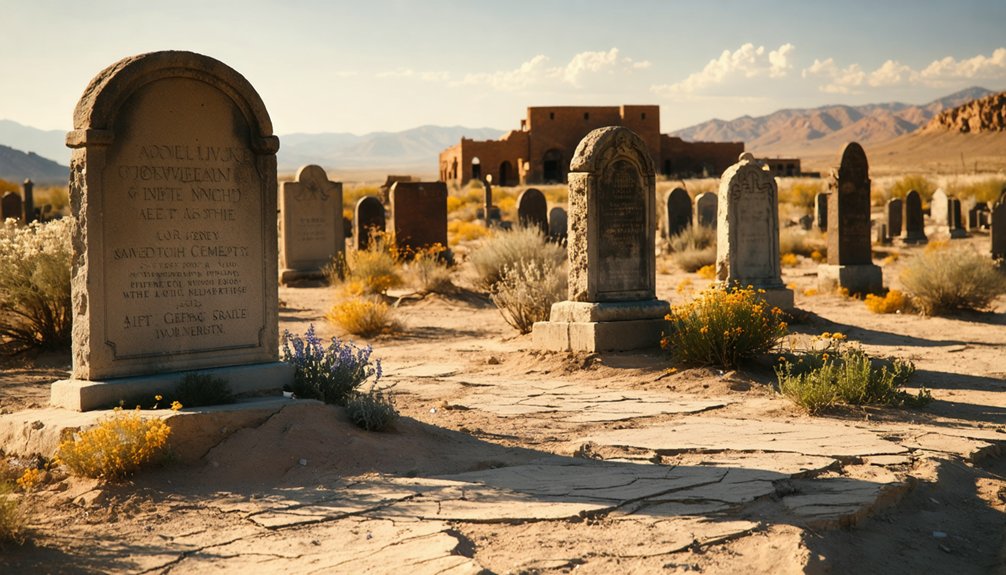
Since 1865, the Elgin Cemetery has chronicled over 150 years of local history through its uniquely adorned gravesites.
You’ll find personalized plots decorated with wagon wheels, toys, and seasonal ornaments that tell stories beyond mere dates on headstones. These grave adornments reflect the area’s evolution from pioneer settlement to uranium mining and Cold War military presence.
Though Elgin itself is now a ghost town, the cemetery remains active, serving families in nearby Green River.
Cemetery preservation efforts focus on protecting both the physical markers and the distinctive decorative traditions that make this site special. The remote location presents challenges, but local caretakers continue maintaining this crucial link to the region’s past, ensuring that pioneer and post-pioneer narratives endure through these deeply personal memorials.
Physical Remnants and Historical Sites
Today in Elgin, Utah, you’ll find a haunting collection of five surviving buildings among the ghostly remnants of what was once a bustling community of over 30 structures.
The adobe schoolhouse stands as the most prominent survivor, while scattered ruins of homes, mining operations, and transportation infrastructure tell stories of a forgotten era.
Time-weathered adobe walls stand sentinel among scattered ruins, bearing witness to a community’s vanished dreams and forgotten stories.
As you explore these historical remnants, you’ll discover traces of wooden sidewalks, abandoned railroad grades, and mining equipment that once powered this thriving settlement.
- Crumbling walls whisper tales of families who once called these empty structures home
- Mining artifacts lie silent, preserving the town’s industrial heritage
- Nature slowly reclaims the streets where workers and children once walked
- Weather-worn foundations mark the footprints of lost dreams and ambitions
Modern Access and Preservation Efforts
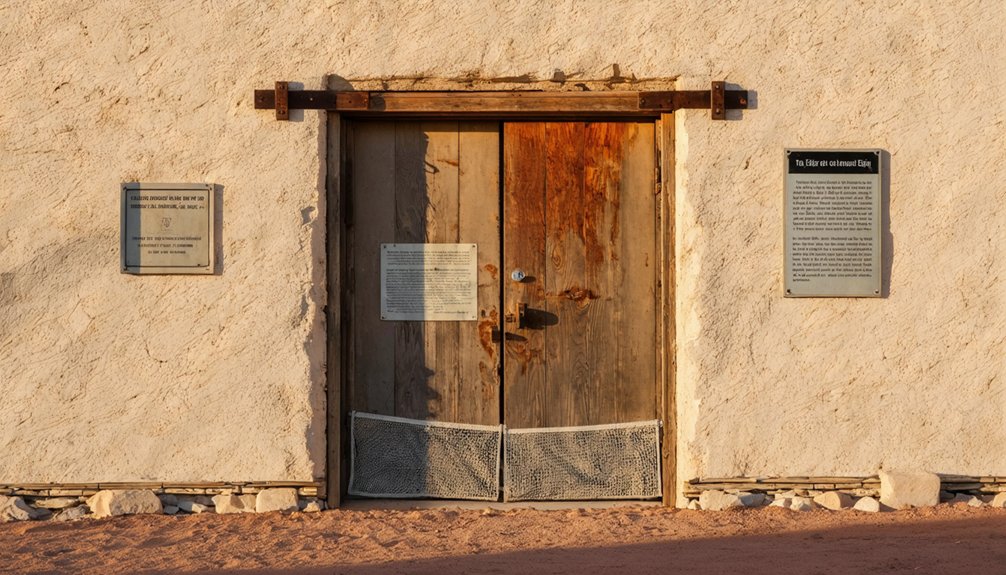
While accessing Elgin’s historic remnants requires careful planning, you’ll need a high-clearance vehicle to navigate the rural dirt roads leading to this remote ghost town.
Weather conditions can greatly impact accessibility challenges, as rain and snow often make roads impassable. You won’t find modern amenities or a visitor center on-site, creating an authentic but primitive experience.
Local historical societies and volunteers are spearheading preservation initiatives through partnerships with state agencies.
They’re working to document artifacts, stabilize structures, and prevent further decay. Though Elgin currently lacks official heritage designation, preservation advocates are seeking National Register status to secure legal protection and preservation grants.
These efforts mirror successful models from nearby ghost towns, where archaeological research and community engagement have helped protect historical resources while maintaining public access.
Frequently Asked Questions
What Native American Tribes Originally Inhabited the Elgin Area Before Settlement?
You’ll find the Ute Tribe dominated this region, with their bands living near rivers and lakes, while Shoshone influence extended from the north, creating overlapping territories across eastern Utah’s landscape.
Were There Any Notable Crimes or Lawlessness Reported in Elgin?
You won’t find documented crime history or law enforcement incidents in Elgin’s records. The town’s legacy centers on peaceful peach farming rather than any notable outlaw activity or lawlessness.
What Happened to the Original Buildings and Structures of Elgin?
Like many frontier remnants, you’ll find the buildings deteriorating from nature’s harsh touch. Most original structures haven’t survived, with weathered wooden frames and adobe walls crumbling despite their historical significance to building preservation efforts.
Did Any Famous Historical Figures Ever Visit or Stay in Elgin?
You won’t find any documented famous visitors to this frontier outpost. Historical significance stems from local pioneers and railroad activity, not celebrity presence or notable historical figures passing through.
What Natural Disasters Affected Elgin During Its Inhabited Years?
Like scattered leaves in history’s wind, you won’t find clear records of major natural disasters. While regional floods and earthquakes impacted Utah’s southeast, Elgin itself escaped direct flood damage or significant earthquake impact.
References
- https://www.stephenwade.com/blog/articles/sunday-drive-old-irontown-utahs-first-ghost-town
- https://www.atlasobscura.com/places/elgin-cemetery-sentimental-statues
- https://lifeinutopia.com/utah-ghost-towns
- https://www.grandcountyutah.net/388/Ghost-Towns-Communities
- https://en.wikipedia.org/wiki/Old_Irontown
- https://www.uen.org/utah_history_encyclopedia/g/GREEN_RIVER_TOWN.shtml
- https://cegu.uchicago.edu/2023/05/12/green-river-utah/
- https://www.familysearch.org/en/wiki/Green_River
- https://octa-trails.org/wp-content/uploads/2023/08/Grady-et-al.-An-Archeological-Overview-and-Management-Plan-for-.pdf
- https://en.wikipedia.org/wiki/Green_River
